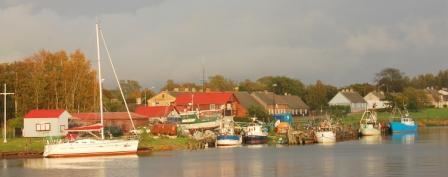Founded 1879 Time zone EET (UTC+2) Area 6.29 km² | District Pāvilosta municipality Town Rights 1991 Postal code LV-3466 Local time Monday 5:36 AM | |
 | ||
Weather 1°C, Wind SE at 5 km/h, 95% Humidity | ||
Liep jas br i p vilosta
Pāvilosta ( pronunciation ; German: Paulshafen) is a small port town in Latvia located at the mouth of Saka river in Courland.
Contents
- Liep jas br i p vilosta
- Map of PC481vilosta PC481vilostas pilsC493ta LV 3466 Latvia
- P vilosta
- History
- References
Map of P%C4%81vilosta, P%C4%81vilostas pils%C4%93ta, LV-3466, Latvia
P vilosta
History
The territory of modern Pāvilosta has been inhabited since the Stone age. During the late iron age and the Livonian crusade the territory was inhabited by Curonians and was part of the Piemare land. In 1253 in agreement between Bishop of Courland and Livonian Order port at the mouth of Saka river is mentioned for the first time. In the later years small port named Sackenhausen was part of the Bishopric of Courland, Duchy of Courland and Semigallia and since 1795 Russian Empire.
In 1879 local landlord from nearby Upesmuiža manor Otto Friedrich von Lilienfeld started extensive reconstruction works of the small port. New port town was named Paulshafen, after baron's brother General governor of the Courland Governorate Paul von Lilienfeld. However development of the town is not so fast as von Lilienfeld has planned. Many building plots are available for rent but during ten years only ten buildings are built. Port is used only by several fishermen and three small sailers owned by nearby manors.
Real development of the town started in 1893 when building of Liepāja military port (Karosta) started. Pāvilosta became main centre for transporting stones to the Liepāja. Port was adjusted for stone shipment and many builders, workers and sailors came to the town. When stone shipment stopped town already had good port and shipping infrastructure. Until First World War there were three shipyards in the town where small one mast ships were built. However several bigger two mast schooners for international voyages also were built in the town. Overal 15 ships were built in the Pāvilosta. In 1913 Pāvilosta received limited town rights.
During the First World War Pāvilosta was occupied by the German Imperial army and saw heavy destruction. Almost all of the Pāvilosta fleet was destroyed, sold or confiscated. After the war only two motor boats and four sailers were left in port. In the Republic of Latvia the port shifted its focus from merchant ships to fishery. In 1930 a fishermens' cooperative was established in the town. In 1939 a Lutheran church was consecrated in the town.
After the Occupation of Latvia in 1940 all fishermen were forced to unite in artel. During battles in the Courland Pocket several fishermen families fled from the second Soviet occupation with motor boats to Gotland, only 150 kilometres to the west. After the war Pāvilosta became a port town in the Latvian SSR. Local fishermen artel used motor boats until 1949 when the first fishing ship was bought. In 1951 artel was transformed into fishermen kolkhoz Dzintarjūra (Amber sea). In 1975 the kolkhoz was merged with Liepāja fishermen kolkhoz Boļševiks (The Bolshevik). In the 1970s there were around 20 fishing trawlers in Pāvilosta port.
After 1991 Pāvilosta again became part of Republic of Latvia. It was granted town rights in 1991. In 1994 stock company Pāvilosta was established who today owns two fishing trawlers. Today port is used mainly by local fishermen boats and tourist yachts. There is also sailing and windsurfing school in the town who owns several yachts.
